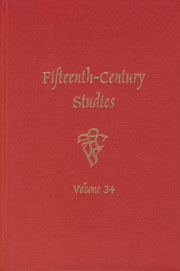Book contents
- Frontmatter
- Contents
- Essays
- 1 The Current State of Research on Late-Medieval Drama. 2007–2008: Survey, Bibliography, and Reviews
- 2 Poetry as Source for Illustrated Prose: The 1519 Strassburg Wigoleis vom Rade
- 3 The St. Edith Cycle in The Salisbury Breviary (c.1460)
- 4 L'épanouissement de l'histoire au quinzième siècle en France
- 5 Escuelas de traducción en la Edad Media
- 6 Ten Poems from the Gruuthuse Songbook (c.1462)
- 7 Louis XI, A French Monarch in Pilgrim's Garb: Badges
- 8 Robert Henryson's Morall Fabilles: Irony, Allegory, and Humanism in Late-Medieval Fables
- 9 Defining Violence in Middle English Romances: Sir Gowther and Libeaus Desconus
- 10 Presencia y Ausencia de los Judíos en los Sermons de quaresma de Vicente Ferrer
- 11 “Als ich dich vor gelert haun”: Conrad Buitzruss's Recipe Collection in Manuscript Clm 671 (Munich)
- 12 Book Reviews
3 - The St. Edith Cycle in The Salisbury Breviary (c.1460)
from Essays
Published online by Cambridge University Press: 05 September 2013
- Frontmatter
- Contents
- Essays
- 1 The Current State of Research on Late-Medieval Drama. 2007–2008: Survey, Bibliography, and Reviews
- 2 Poetry as Source for Illustrated Prose: The 1519 Strassburg Wigoleis vom Rade
- 3 The St. Edith Cycle in The Salisbury Breviary (c.1460)
- 4 L'épanouissement de l'histoire au quinzième siècle en France
- 5 Escuelas de traducción en la Edad Media
- 6 Ten Poems from the Gruuthuse Songbook (c.1462)
- 7 Louis XI, A French Monarch in Pilgrim's Garb: Badges
- 8 Robert Henryson's Morall Fabilles: Irony, Allegory, and Humanism in Late-Medieval Fables
- 9 Defining Violence in Middle English Romances: Sir Gowther and Libeaus Desconus
- 10 Presencia y Ausencia de los Judíos en los Sermons de quaresma de Vicente Ferrer
- 11 “Als ich dich vor gelert haun”: Conrad Buitzruss's Recipe Collection in Manuscript Clm 671 (Munich)
- 12 Book Reviews
Summary
The study of liturgical manuscripts has experienced a wealth of interdisciplinary activity in the last five years. Richard K. Emmerson has noted that examinations of illuminated manuscripts
have shifted from exclusive concern with stylistic and iconographic analyses to more extensive attention to the semiotics of representation and seeing and to the contextualization of image reception within social (e.g., interpretive communities) and material (e.g., the whole book) contexts.
Interdisciplinary analyses of deluxe illuminated manuscripts can thus provide contextualizations that include cultural and political considerations; for example, a recent analysis of the ordo of St. Louis demonstrates that this manuscript was “ordered to serve the political and ideological plans of Saint Louis,” so that “both the visual and the textual content of this codex cooperate to fully realize a monument to the glory of the very Christian sovereign.”
The deluxe manuscript called the Salisbury Breviary also lends itself to such an analysis. This breviary is a good example of what John Lowden has recently termed a “nonworking, luxury” copy of a liturgical book not used in religious ceremonies. Paris, Bibliothèque Nationale de France, MS lat. 17294, did not fulfill the ostensible, practical purpose of a breviary owned by a layperson instead of a religious institution because the volume was not primarily a book of texts and images that would allow its owner to follow church services. Like a number of the illuminated manuscripts Lowden discusses, the Salisbury Breviary's cultural function was glorification of its patron, John of Lancaster, Duke of Bedford (1389–1435).
- Type
- Chapter
- Information
- Fifteenth-Century Studies , pp. 48 - 63Publisher: Boydell & BrewerPrint publication year: 2009



